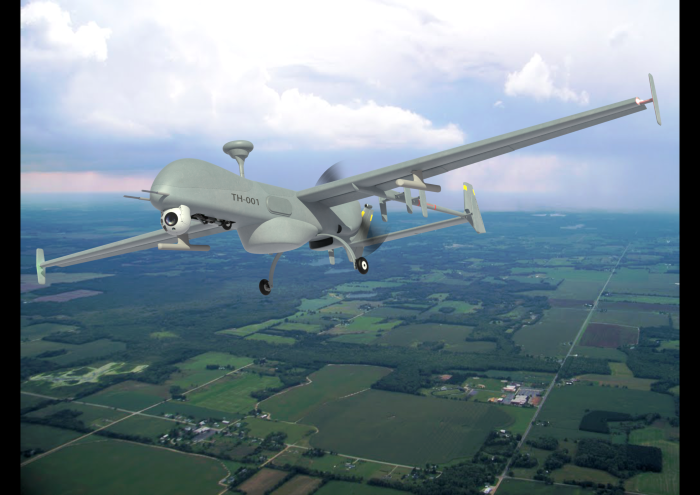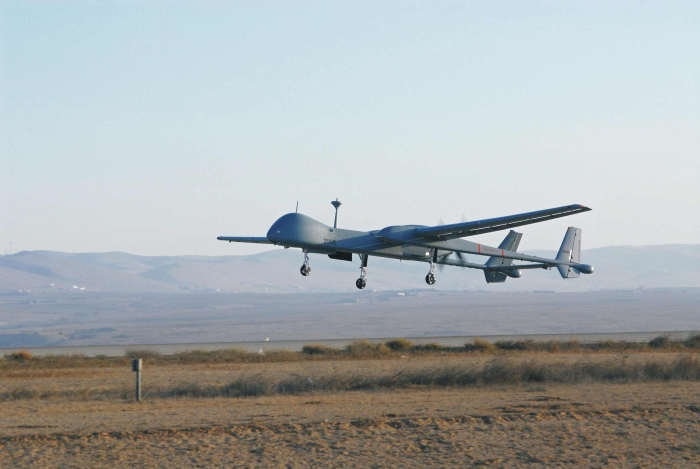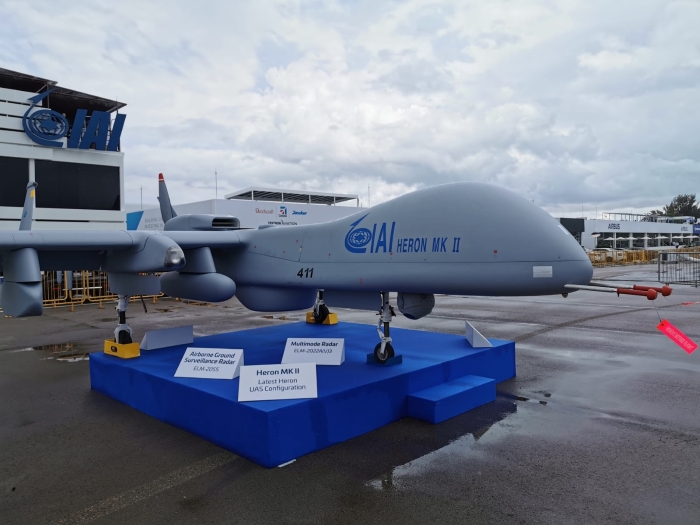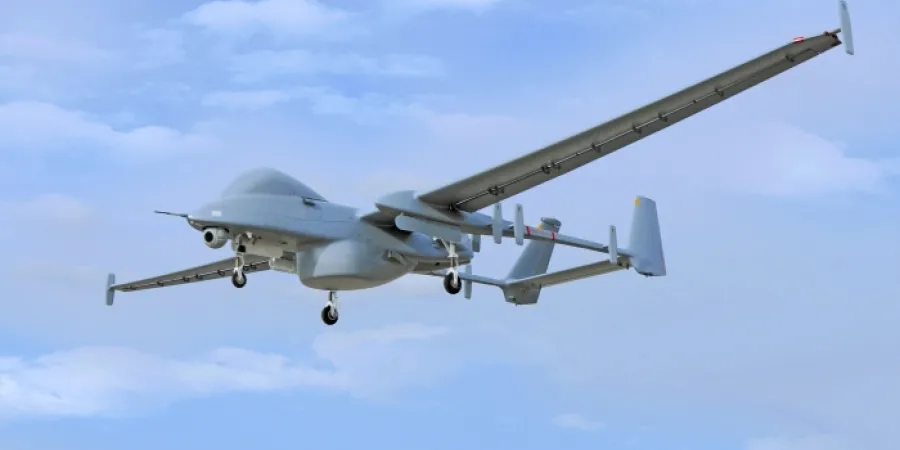IAI's Heron family of drones offer effective, proven airborne solutions
The UAS with advanced design, technology and durability have evolved over the years to carry out a wide range of missions in various environments
IsraelDefense
|
29/10/2020
Based on their experience with the first generation of tactical Unmanned Aerial Systems (UAS), customers wanted UAS that could do more – fly longer missions, carry heavier payloads, endure longer missions, and soar higher. Realizing that addressing all those demands by mere upgrading of tactical platforms was not possible, IAI designers started to develop a larger, more capable platform that would take UAS capabilities to a new level. That’s how the Heron family was conceived.
In 1994, IAI introduced the first Heron variant – a platform weighing 1.18 tons on takeoff that could climb to 30,000 ft., its propulsion provided by an engine that enabled the drone to fly clandestine intelligence gathering missions without the distinctive "sawmill" noise created by other drones.
The Heron platform proved highly flexible and was adapted to different missions through the introduction of the world’s first multi-mission UAS. “These capabilities demand high reliability and solid design that address the different operational needs and doctrines,” said Avi Bleser, Vice President Marketing and Sales at IAI’s Military Aircraft Group. “The experience we gained in four decades of operations with more than 50 customers worldwide has shaped the ongoing evolution of the Heron family." This includes deploying from runways at an altitude of 11,000 ft. from airbases in the Himalayas or the Andes, operating in temperature extremes from +45 to -40 degrees Celsius, and flying through pouring monsoon rains and high winds.
By 1998, with the introduction of the Heron Mk 1 as the world’s first UAS, the platform carried 470 kg of fuel and payload, comprised of EO/IR, radar, SIGINT and COMINT sensors and a broadband datalink that transmitted to the ground station the information collected by the sensors.
Another variant optimized to support naval operations is the Maritime Heron, equipped with maritime search radar, AIS, EO/IR payload and Electronic Support Measures (ESM). Leveraging satellite communications to extend missions beyond the horizon, Maritime Herons often deploy on long-range patrols or in support of naval task forces, utilizing forward mission control elements carried onboard naval vessels.
Since the introduction of the first Heron, the family has continued to evolve to meet customer needs, resulting in the faster, larger, and higher-flying Heron TP. Powered by a turboprop engine, the Heron TP flies at more than twice the speed of the Heron. Although it is almost five times heavier, Heron TP climbs faster to a ceiling of 45,000 feet and carries payloads of over one ton.
The Heron TP also introduced modular architecture building blocks that quickly tailored the platform for different missions. This architecture enables customers to continuously upgrade platforms by inserting advanced capabilities as technology progresses. The modern architecture and enhanced sensor payloads are now used throughout the family.
This modular and scalable architecture also resulted in two new family members – the Heron MK II and the smallest platforms in the family - the T-Heron. While the Heron MK II serves as the next generation platform succeeding the Mk I and Maritime Heron, T-Heron fulfills the role of tactical UAS previously performed by IAI’s Searcher MKII. T-Heron performs missions at a short and medium range, supporting ground operations. Both carry multiple payloads, and operate the entire range of payloads operated by other members of the Heron family, including EO/IR, radar and electronic surveillance, and are limited only by the platform’s load and space availability.
Utilization of open architecture, communications protocols and information sharing enables the integration of other assets with the Heron. These include the BirdEye 650D Small Tactical UAS and the VTOL Panther family.
With SATCOM communications integrated, IAI Herons can now employ ‘Long Runner’ to operate remotely in the air and on the ground, requiring minimal ground support at a remote operating base. The Long Runner is part of IAI’s centralized Mission Operation & Intelligence Center (MOIC), supporting the operation of multiple Heron drones of different types, carrying various payloads, and operating at different distances and directions. MOIC provides an efficient integration of the intelligence and situational pictures by flexibly allocating assets to support evolving situations and operational needs. The intelligence processing systems associated with the Heron family are also designed with powerful, semi-automatic target location, classification and designation workflow, optimizing the operator’s efficiency and capacity.
Besides the centralized operation, Heron UAS are designed to closely support users at the tactical and operational level, employing platform and mission autonomy to handle active payload control by the user, while the platform flies autonomously or under remote control.
In use by 22 customers throughout the world, among them India, Israel, Germany, South Korea, and Brazil, Heron family UAS have accumulated over 500,000 operational flight hours. “The utilization has increased threefold over past generations,” said Avi Bleser from IAI’s Military Aircraft Group. “Besides the robust and scalable system it provides, the exceptional operational experience and numerous technical variations that evolved to meet the needs of the Heron community define the Heron family as the leader in UAS.”

The T-Heron. Photo: IAI

The Heron TP. Photo: IAI

The Heron MKII. Photo: IAI
The UAS with advanced design, technology and durability have evolved over the years to carry out a wide range of missions in various environments
Based on their experience with the first generation of tactical Unmanned Aerial Systems (UAS), customers wanted UAS that could do more – fly longer missions, carry heavier payloads, endure longer missions, and soar higher. Realizing that addressing all those demands by mere upgrading of tactical platforms was not possible, IAI designers started to develop a larger, more capable platform that would take UAS capabilities to a new level. That’s how the Heron family was conceived.
In 1994, IAI introduced the first Heron variant – a platform weighing 1.18 tons on takeoff that could climb to 30,000 ft., its propulsion provided by an engine that enabled the drone to fly clandestine intelligence gathering missions without the distinctive "sawmill" noise created by other drones.
The Heron platform proved highly flexible and was adapted to different missions through the introduction of the world’s first multi-mission UAS. “These capabilities demand high reliability and solid design that address the different operational needs and doctrines,” said Avi Bleser, Vice President Marketing and Sales at IAI’s Military Aircraft Group. “The experience we gained in four decades of operations with more than 50 customers worldwide has shaped the ongoing evolution of the Heron family." This includes deploying from runways at an altitude of 11,000 ft. from airbases in the Himalayas or the Andes, operating in temperature extremes from +45 to -40 degrees Celsius, and flying through pouring monsoon rains and high winds.
By 1998, with the introduction of the Heron Mk 1 as the world’s first UAS, the platform carried 470 kg of fuel and payload, comprised of EO/IR, radar, SIGINT and COMINT sensors and a broadband datalink that transmitted to the ground station the information collected by the sensors.
Another variant optimized to support naval operations is the Maritime Heron, equipped with maritime search radar, AIS, EO/IR payload and Electronic Support Measures (ESM). Leveraging satellite communications to extend missions beyond the horizon, Maritime Herons often deploy on long-range patrols or in support of naval task forces, utilizing forward mission control elements carried onboard naval vessels.
Since the introduction of the first Heron, the family has continued to evolve to meet customer needs, resulting in the faster, larger, and higher-flying Heron TP. Powered by a turboprop engine, the Heron TP flies at more than twice the speed of the Heron. Although it is almost five times heavier, Heron TP climbs faster to a ceiling of 45,000 feet and carries payloads of over one ton.
The Heron TP also introduced modular architecture building blocks that quickly tailored the platform for different missions. This architecture enables customers to continuously upgrade platforms by inserting advanced capabilities as technology progresses. The modern architecture and enhanced sensor payloads are now used throughout the family.
This modular and scalable architecture also resulted in two new family members – the Heron MK II and the smallest platforms in the family - the T-Heron. While the Heron MK II serves as the next generation platform succeeding the Mk I and Maritime Heron, T-Heron fulfills the role of tactical UAS previously performed by IAI’s Searcher MKII. T-Heron performs missions at a short and medium range, supporting ground operations. Both carry multiple payloads, and operate the entire range of payloads operated by other members of the Heron family, including EO/IR, radar and electronic surveillance, and are limited only by the platform’s load and space availability.
Utilization of open architecture, communications protocols and information sharing enables the integration of other assets with the Heron. These include the BirdEye 650D Small Tactical UAS and the VTOL Panther family.
With SATCOM communications integrated, IAI Herons can now employ ‘Long Runner’ to operate remotely in the air and on the ground, requiring minimal ground support at a remote operating base. The Long Runner is part of IAI’s centralized Mission Operation & Intelligence Center (MOIC), supporting the operation of multiple Heron drones of different types, carrying various payloads, and operating at different distances and directions. MOIC provides an efficient integration of the intelligence and situational pictures by flexibly allocating assets to support evolving situations and operational needs. The intelligence processing systems associated with the Heron family are also designed with powerful, semi-automatic target location, classification and designation workflow, optimizing the operator’s efficiency and capacity.
Besides the centralized operation, Heron UAS are designed to closely support users at the tactical and operational level, employing platform and mission autonomy to handle active payload control by the user, while the platform flies autonomously or under remote control.
In use by 22 customers throughout the world, among them India, Israel, Germany, South Korea, and Brazil, Heron family UAS have accumulated over 500,000 operational flight hours. “The utilization has increased threefold over past generations,” said Avi Bleser from IAI’s Military Aircraft Group. “Besides the robust and scalable system it provides, the exceptional operational experience and numerous technical variations that evolved to meet the needs of the Heron community define the Heron family as the leader in UAS.”

The T-Heron. Photo: IAI

The Heron TP. Photo: IAI

The Heron MKII. Photo: IAI



